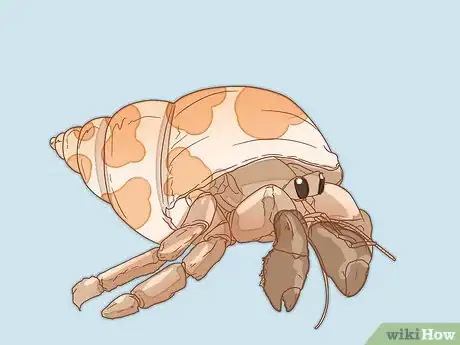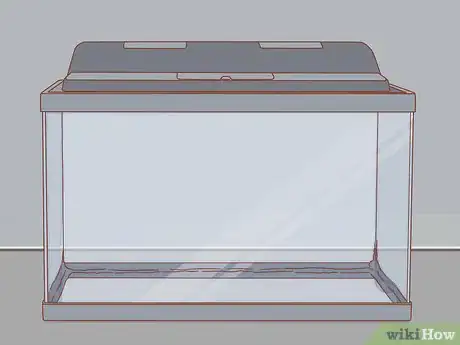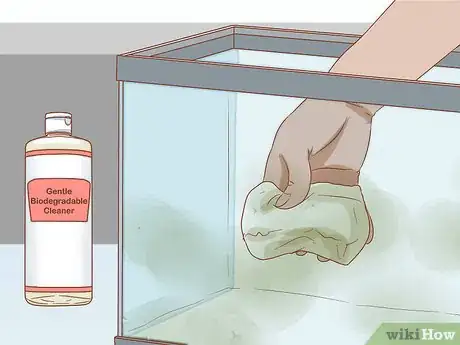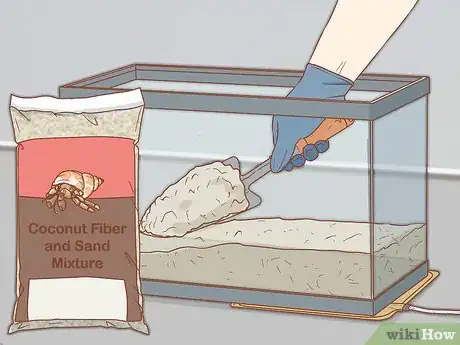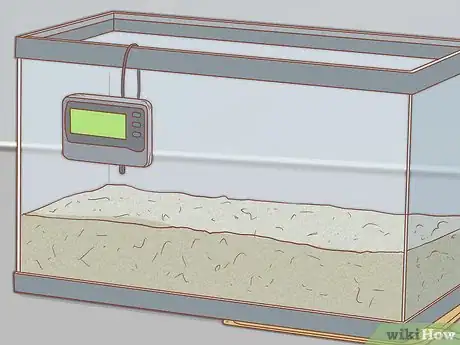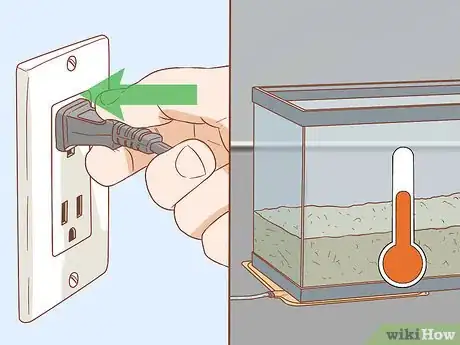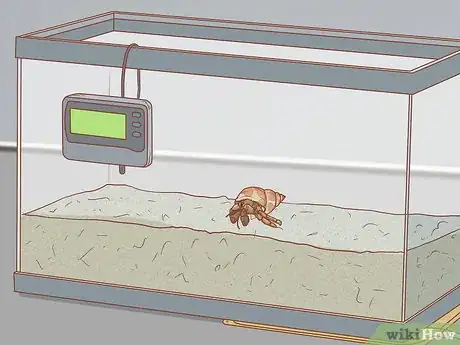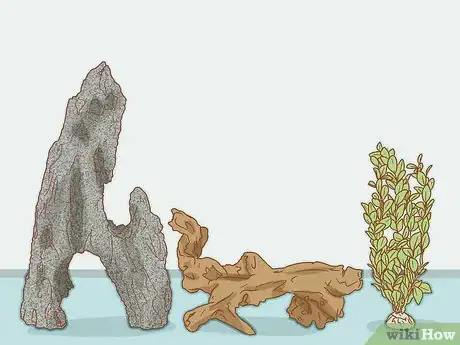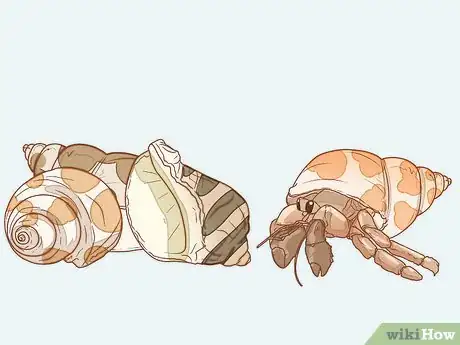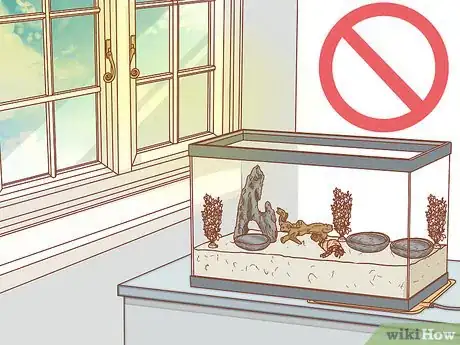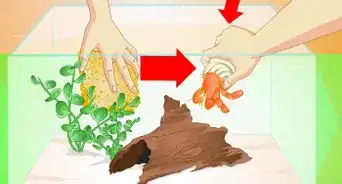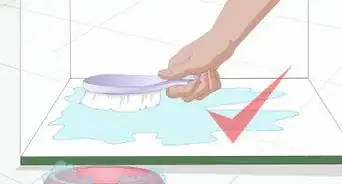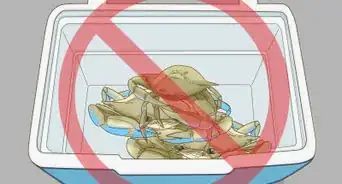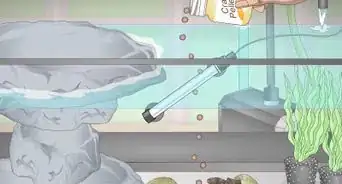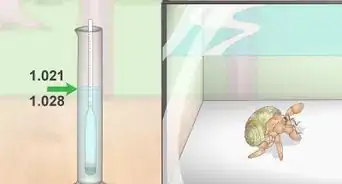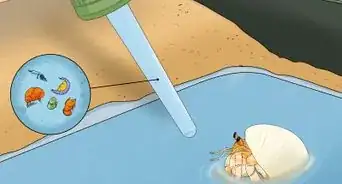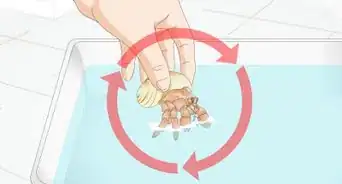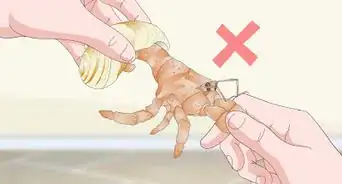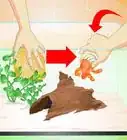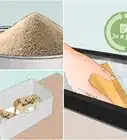This article was co-authored by Deanne Pawlisch, CVT, MA. Deanne Pawlisch is a Certified Veterinary Technician, who does corporate training for veterinary practices and has taught at the NAVTA-approved Veterinary Assistant Program at the Harper College in Illinois and in 2011 was elected to the board of the Veterinary Emergency and Critical Care Foundation. Deanne has been a Board Member of the Veterinary Emergency and Critical Care Foundation in San Antonio, Texas since 2011. She holds a BS in Anthropology from Loyola University and an MA in Anthropology from Northern Illinois University.
wikiHow marks an article as reader-approved once it receives enough positive feedback. In this case, 83% of readers who voted found the article helpful, earning it our reader-approved status.
This article has been viewed 139,382 times.
Whether we’re talking about hermit, moon, or aquatic, it takes a lot of careful work to keep crabs healthy and happy. The first step is setting up a proper crabitat. You need to get a big tank, with plenty of substrate and accessories. Then, you need to get the equipment to maintain the delicate balance of humidity and heat required to keep crabs healthy.
Steps
Setting up the Tank
-
1Begin setup before you pick up your crabs. Crabs can be adversely affected by rapid changes in temperature and humidity. Be sure that the crabitat is completely set up and stabilized prior to bringing your new pets home.[1]
-
2Buy a large glass aquarium. For two medium-sized crabs, the aquarium should be at least 10 gallons. Two large crabs or several medium sized crabs will require a larger tank, maybe 30 or 40 gallons.[2]
- Crabs can escape if the tank does not have a secure lid. Glass or plexiglass is preferable.[3]
- There are two types of glass tanks, terrariums and aquariums. Buy an aquarium, because many terrariums are not strong enough to hold the amount of substrate necessary for a crab.
Advertisement -
3Clean your aquarium with a gentle biodegradable cleaner. Wipe down the tank with a towel and cleaner that is not dangerous for animals. Consider using a mixture of vinegar and water. Mix the two evenly and the dunk your towel in the solution. After you are done, rinse the tank out with fresh water and wipe it down with a dry towel to pick up moisture.[4]
-
4Attach the heater. Many heaters are housed under the tank. Thus, it is better to attach these before you fill it up so you don’t have to lift a heavy tank. Specifications for how to attach the heater vary depending upon the heater.[5]
-
5Fill the tank with a deep layer of substrate. There needs to be enough substrate in the tank that the crab can dig and hide itself completely under the sand. The amount necessary varies somewhat depending upon the size of the crab. The best substrate is a mixture of coconut fiber and sand. Mix approximately 5 parts sand to one part coconut fiber.
- Prepare coconut fiber according to directions on the box. Then mix it carefully with sand until the coconut fiber is well distributed throughout the substrate. Crabs normally dig in sand and love it as substrate. However, coconut fiber is better at retaining humidity, which is important in an artificial crabitat.
- For crabs the size of a quarter or smaller you should have at least six inches of substrate.
- For crabs about the size of a golf ball, you should have about six to eight inches of substrate.
- Crabs as large as a tennis ball require eight to ten inches of substrate.
- Anything larger than a baseball will require at least 12 inches of substrate, possibly more.
-
6Attach the thermometer and hygrometer. Attach these so that you can begin getting the tank to an appropriate humidity and temperature. Specifications for how to attach these instruments vary depending upon the model.[6]
- Most types of crabs prefer a temperature of approximately 78 degrees Fahrenheit (25 degrees Celsius). Install the thermometer to be sure that the temperature remains around this temperature.
- Hermit crabs need moist, humid air to breathe properly. To be sure that the air is sufficiently moist, get a hygrometer to test the air. Relative humidity levels should always be between 60 to 80 percent in the crabitat.
-
7Moisten the tank. The tank should have a relative humidity of 60 to 80 percent. Soaking sand is a dangerous way to accomplish. Get a hand mister and spray it in the tank until the hygrometer reads an acceptable humidity level. Alternatively, consider purchasing a fogger or humidifier.[7]
- Depending on the humidity in your area, you might find that keeping up the humidity with a hand mister can be very laborious. If that is the case, a fogger or humidifier might be better, but be sure to monitor it to make sure that it is not flooding the tank.
- Using coconut fiber substrate and a glass lid for the tank will help it retain humidity.
-
8Heat the tank up to an appropriate temperature. Try to keep the tank at about 78 degrees Fahrenheit. The easiest way to accomplish this is to use an automatic heater. However, a lamp can also help raise the temperature of the tank. If you are using a lamp, try to position it so that it does not shine on the entire area and the crab get out of the heat if it chooses.
- Consider getting a heater that can automatically turn off once it registers that the tank has reached the desired temperature.
-
9Introduce your crabs to their new home. When the temperature and the humidity are acceptable in the tank, put your crabs in the tank. Watch them explore their new home!
Adding Accessories
-
1Insert two water bowls and one food bowl. The tank should have a dish for dechlorinated fresh water and dechlorinated saltwater. The water dishes should be big enough that your crab can submerge itself completely in them, but not so big that it can’t get in and out of it. The food bowl should be smaller than the water bowls.
- The salt water bowl should be filled with a mixture of dechlorinated water and aquarium salt mix. You cannot mix table salt into the water.[8]
-
2Buy hiding and climbing objects. Crabs love to climb over objects and also hide underneath them, so you should fill the crabitat with plenty of good items that are suitable for this. Appropriate toys and objects include wooden and plastic houses, jagged rocks, driftwood, and fake plants. Be sure that the tank is large enough to accommodate the toys without overcrowding your crabs.[9]
-
3Get at least three extra shells per crab. Crabs love to change shells, so there should be a few in the crabitat to play with. Only use shells that have been cleaned and sanitized.[10]
- Crabs typically prefer shells that fit snugly, without only a little bit of extra room. Be sure to get a shell with an opening about 1/8 to ¼ an inch bigger than the crabs claw. Experiment with a few sizes to see what your crab prefers.
- Some crabs prefer shells that have round openings, whereas other prefer a D-shaped opening. Purple Pinchers generally prefer round openings. Ecuadorians generally prefer D-shaped openings. Watch to see which your carb seems to prefer.
- Never give a crab a painted shell. This can be hazardous to their health.[11]
Picking a Spot for Your Tank
-
1Keep the tank away from air-condition vents. You need to ensure that the tank is at a steady, acceptable temperature. If it is near a vent, it can be exposed to gusts of cold air that are dangerous for the crabs.
-
2Keep it out of direct sunlight. Whether it is near a window or outside, keep the tank away from direct sunlight. Crabs don’t much care for sunlight and it can heat the tank up dangerously.
-
3Find a busy spot, but not too busy. It is best to keep your crabs somewhere you will see them often, so that you can check up on them. However, don’t put them someplace where you use sprays that are hazardous to them, like hair spray, cologne, and room deodorants. They should be loud and rowdy at night, so you might want to refrain from putting them in your bedroom.
Expert Q&A
-
QuestionWhat kind of water do I need to provide for my hermit crabs?
 Deanne Pawlisch, CVT, MADeanne Pawlisch is a Certified Veterinary Technician, who does corporate training for veterinary practices and has taught at the NAVTA-approved Veterinary Assistant Program at the Harper College in Illinois and in 2011 was elected to the board of the Veterinary Emergency and Critical Care Foundation. Deanne has been a Board Member of the Veterinary Emergency and Critical Care Foundation in San Antonio, Texas since 2011. She holds a BS in Anthropology from Loyola University and an MA in Anthropology from Northern Illinois University.
Deanne Pawlisch, CVT, MADeanne Pawlisch is a Certified Veterinary Technician, who does corporate training for veterinary practices and has taught at the NAVTA-approved Veterinary Assistant Program at the Harper College in Illinois and in 2011 was elected to the board of the Veterinary Emergency and Critical Care Foundation. Deanne has been a Board Member of the Veterinary Emergency and Critical Care Foundation in San Antonio, Texas since 2011. She holds a BS in Anthropology from Loyola University and an MA in Anthropology from Northern Illinois University.
Certified Veterinary Technician For hermit crabs, you should provide salt water and non-chlorinated fresh water at all times. Each bowl of water should be large enough for the largest crab you have to get into.
For hermit crabs, you should provide salt water and non-chlorinated fresh water at all times. Each bowl of water should be large enough for the largest crab you have to get into. -
QuestionWhat is an air stone?
 Deanne Pawlisch, CVT, MADeanne Pawlisch is a Certified Veterinary Technician, who does corporate training for veterinary practices and has taught at the NAVTA-approved Veterinary Assistant Program at the Harper College in Illinois and in 2011 was elected to the board of the Veterinary Emergency and Critical Care Foundation. Deanne has been a Board Member of the Veterinary Emergency and Critical Care Foundation in San Antonio, Texas since 2011. She holds a BS in Anthropology from Loyola University and an MA in Anthropology from Northern Illinois University.
Deanne Pawlisch, CVT, MADeanne Pawlisch is a Certified Veterinary Technician, who does corporate training for veterinary practices and has taught at the NAVTA-approved Veterinary Assistant Program at the Harper College in Illinois and in 2011 was elected to the board of the Veterinary Emergency and Critical Care Foundation. Deanne has been a Board Member of the Veterinary Emergency and Critical Care Foundation in San Antonio, Texas since 2011. She holds a BS in Anthropology from Loyola University and an MA in Anthropology from Northern Illinois University.
Certified Veterinary Technician An air stone is a piece of porous stone that is used as a water bubbler. In hermit crab enclosures, this piece of equipment can help with humididty and keep the water pools from becoming stagnant. Some hermit crab owners report that their crabs enjoy playing in the bubbly pools.
An air stone is a piece of porous stone that is used as a water bubbler. In hermit crab enclosures, this piece of equipment can help with humididty and keep the water pools from becoming stagnant. Some hermit crab owners report that their crabs enjoy playing in the bubbly pools. -
QuestionCan you use a keeper sized cage for 2 hermit crabs?
 Deanne Pawlisch, CVT, MADeanne Pawlisch is a Certified Veterinary Technician, who does corporate training for veterinary practices and has taught at the NAVTA-approved Veterinary Assistant Program at the Harper College in Illinois and in 2011 was elected to the board of the Veterinary Emergency and Critical Care Foundation. Deanne has been a Board Member of the Veterinary Emergency and Critical Care Foundation in San Antonio, Texas since 2011. She holds a BS in Anthropology from Loyola University and an MA in Anthropology from Northern Illinois University.
Deanne Pawlisch, CVT, MADeanne Pawlisch is a Certified Veterinary Technician, who does corporate training for veterinary practices and has taught at the NAVTA-approved Veterinary Assistant Program at the Harper College in Illinois and in 2011 was elected to the board of the Veterinary Emergency and Critical Care Foundation. Deanne has been a Board Member of the Veterinary Emergency and Critical Care Foundation in San Antonio, Texas since 2011. She holds a BS in Anthropology from Loyola University and an MA in Anthropology from Northern Illinois University.
Certified Veterinary Technician A keeper sized cage does not provide sufficient room for your hermit crabs. It is recommended that 2 hermit crabs should have at least the space of a 10 gallon aquarium.
A keeper sized cage does not provide sufficient room for your hermit crabs. It is recommended that 2 hermit crabs should have at least the space of a 10 gallon aquarium.
Warnings
- When cleaning your aquarium, remember that harsh chemicals like bleach, some soaps, and glass cleaner can make your hermit crabs ill.⧼thumbs_response⧽
- Never spray tap water in your crabitat.⧼thumbs_response⧽
Things You'll Need
- Aquarium
- Thermometer
- Hydrometer
- Substrate (coconut fiber, sand or other)
- Food dish
- Two water dishes
- Fake plants, hermie hut, ceramic pots, driftwood, and other items to decorate your crabitat with
- Heat Source
- Toys for your hermit crab to play with
- Sand NOT rocks
- Salt water
- Hermie food
References
- ↑ http://www.drsfostersmith.com/pic/article.cfm?aid=2386
- ↑ http://www.drsfostersmith.com/pic/article.cfm?aid=2386
- ↑ http://www.drsfostersmith.com/pic/article.cfm?aid=2386
- ↑ http://www.drsfostersmith.com/pic/article.cfm?aid=2386
- ↑ http://www.drsfostersmith.com/pic/article.cfm?aid=2386
- ↑ http://www.drsfostersmith.com/pic/article.cfm?aid=2386
- ↑ http://hermitcrabassociation.com/phpBB/viewtopic.php?t=92544
- ↑ http://www.drsfostersmith.com/product/prod_display.cfm?pcatid=7321
- ↑ http://www.drsfostersmith.com/pic/article.cfm?aid=2386
About This Article
To set up a crabitat, start by getting a glass aquarium that's 10 gallons or larger, depending on how many crabs you have. Then, set up a heater underneath the aquarium, and line the bottom of the tank with a layer of substrate, like coconut fiber and sand, that's deep enough for your crab to bury itself in. Next, attach a thermometer and hygrometer to the tank so you can monitor the temperature and humidity. Finally, add decorations and some food and water bowls. For more tips from our Veterinary co-author, like how to pick a good spot for your crabitat, read on!
